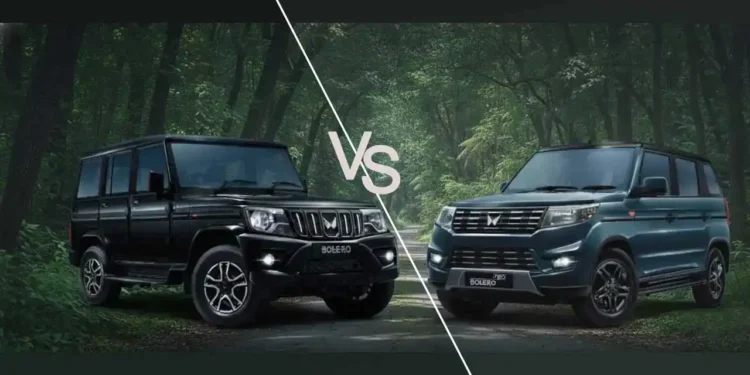So Mahindra just dropped prices on both the Bolero and Bolero Neo, and honestly, the gap between them is now razor-thin. We’re talking ₹7.99 lakh for the Bolero and ₹8.49 lakh for the Neo. That’s just ₹50,000 difference, which got me thinking—is the Neo really worth that extra cash, or should you just stick with the OG Bolero?
I spent the last few days digging into this, and here’s what I found.
The Price Situation
Look, both these SUVs just got some serious price cuts. The Bolero’s down by up to ₹80,000 on some variants, and the Neo dropped by ₹50,000. That’s not pocket change.
Bolero: ₹7.99 lakh to ₹9.99 lakh
Bolero Neo: ₹8.49 lakh to ₹10.49 lakh
What’s interesting is that for the price of a mid-spec Bolero, you can now get a base Bolero Neo. That changes things.
They Look Different (Obviously)
The regular Bolero? It’s the same boxy design that’s been selling like crazy for 20+ years. And you know what? There’s something honest about that. It doesn’t pretend to be anything it’s not. It’s a workhorse, and it looks like one.
The Neo tries harder. The 2025 version gets chrome bits on the grille, LED DRLs, new headlights, and proper 16-inch alloys. It’s still boxy—this is a Mahindra after all—but it’s got more street presence. You can actually park this outside a mall without feeling weird about it.
My take? If you live in a city or semi-urban area, the Neo makes more sense visually. If you’re in rural areas or using it for business, nobody cares what it looks like anyway.
What’s Under the Hood
Here’s where it gets interesting. Both have 1.5-liter diesel engines, but they’re tuned very differently.
| Specification | Mahindra Bolero | Mahindra Bolero Neo |
|---|---|---|
| Price Range | ₹7.99 – ₹9.99 lakh | ₹8.49 – ₹10.49 lakh |
| Engine | 1.5L mHawk75 Diesel | 1.5L mHawk100 Diesel |
| Power | 75 bhp @ 3,600 rpm | 100 bhp |
| Torque | 210 Nm | 260 Nm |
| Transmission | 5-speed Manual | 5-speed Manual |
| Drivetrain | RWD | RWD |
| Mileage | 16 kmpl | 17.29 kmpl |
| Construction | Body-on-Frame | Body-on-Frame |
| Seating Capacity | 7-9 passengers | 7 passengers |
| Fuel Tank | 60 liters | 45 liters |
| Wheelbase | 2,680 mm | 2,680 mm |
| Touchscreen | 7-inch | 7-inch |
| Airbags | 2 (Dual Front) | 2 (Dual Front) |
| ABS + EBD | Yes | Yes |
| Cruise Control | No | Yes |
| Multi Terrain Tech | No | Yes (MTT) |
| Steering Controls | Audio Controls | Audio Controls |
| USB Charging | Type-C | Type-C |
| LED DRLs | No | Yes |
| Alloy Wheels | Steel (16-inch) | Alloy (16-inch) |
| Rear Parking Sensors | Yes | Yes |
That 25 bhp and 50 Nm difference? You’ll feel it. The Neo has proper punch when you need to overtake on highways or climb ghats. The Bolero does the job, but it’s more… leisurely about it.
And check this out—the Neo actually returns better mileage. 17.29 kmpl vs 16 kmpl. Over a year of driving, that pays for some of that ₹50,000 difference right there.
Both are RWD with body-on-frame construction, so they’re equally tough when roads turn bad.
Inside the Cabin
The 2025 updates brought both vehicles closer feature-wise, but the Neo still feels more finished.
Both now get that 7-inch touchscreen (finally!), Type-C charging, steering controls, dual airbags, and parking sensors. Mahindra also threw in leatherette seats on both.
But the Neo adds cruise control—genuinely useful on highways—and this Multi Terrain Technology thing that helps with traction. The dashboard layout is also cleaner and feels less 2010s.
The Bolero’s cabin is functional. Everything works, everything’s where you expect it. But it’s basic. If you’re doing 50-60 km daily commutes, you’ll notice the difference.
So Who Should Buy What?
Go for the Bolero if:
- You need something primarily for work or business use
- Most of your driving is local, not highway
- You’re in rural areas with limited service centers (simpler = easier to fix)
- Every ₹10,000 matters in your budget
- You’re buying for farm use, goods transport, or as a commercial vehicle
- You want maximum seating (it can do 9 passengers in some configs)
Go for the Bolero Neo if:
- You’re using it as a personal/family vehicle
- You do regular highway trips or intercity drives
- You want something that doesn’t scream “utility vehicle”
- Better performance and mileage matter to you
- You value modern features and comfort
- This is your primary vehicle, not a second workhorse
The Bottom Line
Here’s my honest opinion: at ₹50,000 difference, the Neo is the smarter buy for most people. You’re getting significantly better performance, better mileage, more features, and a vehicle that won’t feel outdated in 3 years.
BUT—and this is important—if you’re buying this for commercial work, or if you’re in an area where the nearest service center is 100 km away, the Bolero’s simplicity is actually an advantage. Fewer things to go wrong, easier to fix when they do.
For personal buyers, especially first-time SUV buyers who want that Mahindra toughness without driving something that looks like it belongs on a construction site, the Neo is a no-brainer.
Both vehicles have that body-on-frame construction, proven diesel reliability, and Mahindra’s massive service network. You can’t really go wrong with either—it’s just about matching the vehicle to your actual needs, not what looks good on paper.
What would I buy? If it’s my money and I’m using it as my daily driver, I’m going Neo without thinking twice. That extra power alone is worth it.










